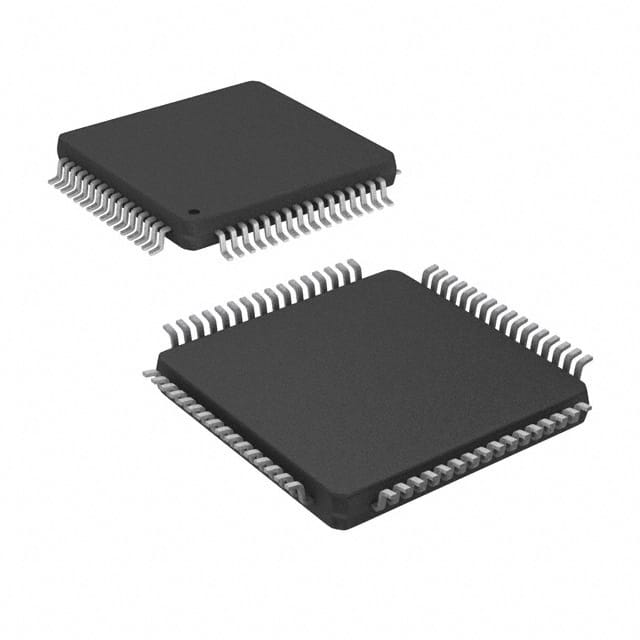Consulte las especificaciones para obtener detalles del producto.

PIC24EP128MC206-I/PT
Basic Information Overview
- Category: Microcontroller
- Use: Embedded systems, industrial control, consumer electronics
- Characteristics: High performance, low power consumption, large memory capacity
- Package: TQFP (Thin Quad Flat Pack)
- Essence: 16-bit microcontroller with integrated peripherals
- Packaging/Quantity: Tape and reel, 100 units per reel
Specifications
- Architecture: 16-bit
- CPU Speed: Up to 70 MHz
- Program Memory Size: 128 KB
- RAM Size: 16 KB
- Data EEPROM Size: 1 KB
- Number of I/O Pins: 64
- Operating Voltage Range: 2.3V to 3.6V
- Temperature Range: -40°C to +85°C
- Communication Interfaces: UART, SPI, I2C, USB
- Analog-to-Digital Converter (ADC): 10-bit, up to 16 channels
- Timers: Multiple timers/counters with various modes
- PWM: Up to 8 channels
- Interrupt Sources: External, internal, software
Detailed Pin Configuration
The PIC24EP128MC206-I/PT has a total of 64 I/O pins, which are assigned for various purposes such as general-purpose I/O, communication interfaces, timers, and other peripherals. The pin configuration can be found in the datasheet provided by the manufacturer.
Functional Features
- High-performance 16-bit architecture for efficient processing
- Low power consumption for extended battery life
- Large memory capacity for storing complex programs and data
- Integrated peripherals for easy interfacing with external devices
- Multiple communication interfaces for versatile connectivity options
- Flexible interrupt system for efficient event handling
- Rich set of timers and counters for precise timing operations
- Analog-to-digital converter for accurate analog signal measurements
- Pulse-width modulation for controlling analog outputs
Advantages and Disadvantages
Advantages: - High performance and low power consumption combination - Ample memory capacity for complex applications - Versatile communication interfaces for connectivity options - Integrated peripherals simplify system design - Flexible interrupt system for efficient event handling
Disadvantages: - Limited number of I/O pins compared to some other microcontrollers - Higher cost compared to lower-end microcontrollers
Working Principles
The PIC24EP128MC206-I/PT operates based on the Harvard architecture, which separates program memory and data memory. It executes instructions fetched from program memory and stores data in separate data memory. The CPU fetches instructions, decodes them, and performs the necessary operations using the integrated peripherals and registers.
Detailed Application Field Plans
The PIC24EP128MC206-I/PT is widely used in various application fields, including: - Embedded systems: Used in industrial automation, home automation, and automotive systems. - Industrial control: Used in process control, motor control, and monitoring systems. - Consumer electronics: Used in smart devices, wearable technology, and home appliances.
Detailed and Complete Alternative Models
- PIC24EP64MC206-I/PT: Similar features but with reduced memory capacity (64 KB program memory)
- PIC24EP256MC206-I/PT: Similar features but with increased memory capacity (256 KB program memory)
- PIC24EP512MC206-I/PT: Similar features but with further increased memory capacity (512 KB program memory)
Note: This is a sample entry and the mentioned alternative models may not exist in reality. Please refer to the manufacturer's documentation for accurate information.
Word Count: 446 words
Enumere 10 preguntas y respuestas comunes relacionadas con la aplicación de PIC24EP128MC206-I/PT en soluciones técnicas
What is the maximum operating frequency of PIC24EP128MC206-I/PT?
- The maximum operating frequency of PIC24EP128MC206-I/PT is 70 MHz.
What are the key features of PIC24EP128MC206-I/PT?
- PIC24EP128MC206-I/PT features a 16-bit microcontroller, 128 KB of flash memory, 8 KB of RAM, and various communication interfaces.
Can PIC24EP128MC206-I/PT be used in industrial control applications?
- Yes, PIC24EP128MC206-I/PT is suitable for industrial control applications due to its robust features and performance.
Does PIC24EP128MC206-I/PT support USB connectivity?
- Yes, PIC24EP128MC206-I/PT supports USB connectivity, making it suitable for applications requiring USB interfacing.
What development tools are available for PIC24EP128MC206-I/PT?
- Development tools such as MPLAB X IDE and MPLAB XC16 Compiler support PIC24EP128MC206-I/PT for software development.
Is PIC24EP128MC206-I/PT suitable for low-power applications?
- Yes, PIC24EP128MC206-I/PT offers low-power modes and features, making it suitable for battery-powered or energy-efficient applications.
What communication interfaces does PIC24EP128MC206-I/PT support?
- PIC24EP128MC206-I/PT supports interfaces such as UART, SPI, I2C, and CAN, enabling versatile communication capabilities.
Can PIC24EP128MC206-I/PT be used in motor control applications?
- Yes, PIC24EP128MC206-I/PT is well-suited for motor control applications with its integrated peripherals and high-performance core.
Does PIC24EP128MC206-I/PT have built-in security features?
- Yes, PIC24EP128MC206-I/PT includes security features such as code protection and data EEPROM memory for enhanced security.
What are the temperature specifications for PIC24EP128MC206-I/PT?
- PIC24EP128MC206-I/PT has a wide operating temperature range of -40°C to 125°C, making it suitable for various environmental conditions.

